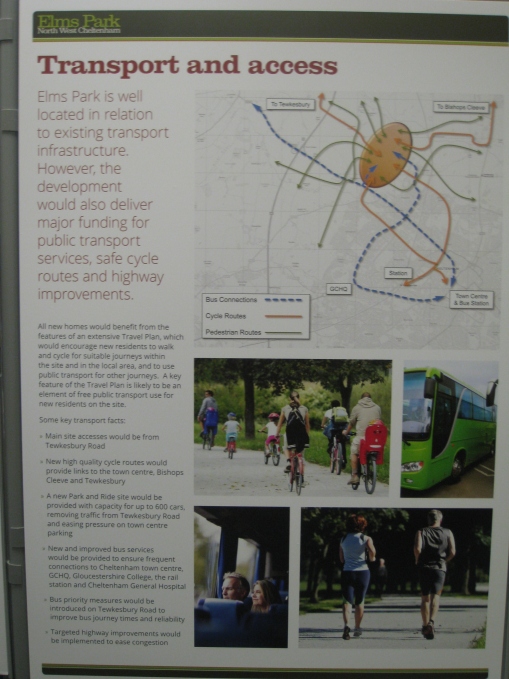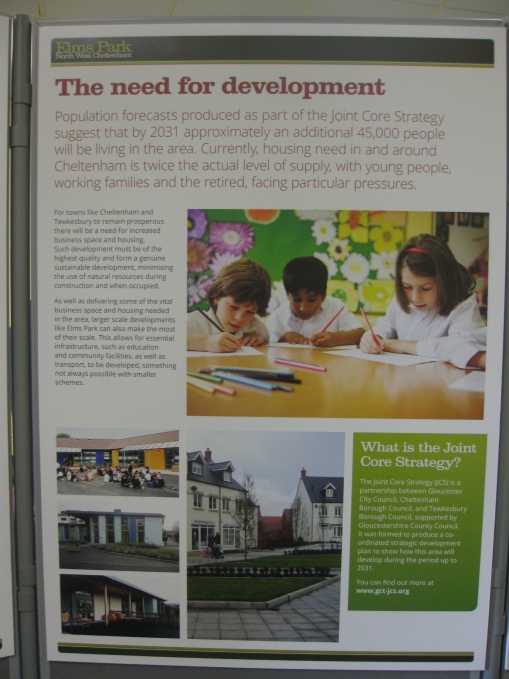It would also see the creation of a new business park, a 600 space park-and-ride, two new primary schools and a secondary school with sixth from.

Developers Bloor Homes and Persimmon Homes have spent more than six years preparing the scheme and they are set to host a series of public exhibitions to gauge public reaction.
Elms Park has the potential to be roughly the same size as the nearby village of Bishop’s Cleeve and would go a long way to helping solve the town’s reported housing crisis.
The homes would be built in three 1,500 unit phases and up to 40 per cent could be designated as affordable.
This would be a mix of rental and shared ownership properties, the equivalent of approximately 1,800 homes.
There is also specific provision set out in the scheme for the elderly with some form of warden-assisted living planned.
A similar scheme was put forward in 2009, but was postponed.
The north west site is already earmarked for housing, with planning documents held by Cheltenham Borough Council suggesting a housing capacity of 4,500.
However, the fact the land is entirely greenbelt is likely to draw the ire of countryside campaigners, determined to ensure green fields are preserved for future generations to enjoy.
The developers hope protestors might be appeased by plans that would see nearly 40 per cent of the site kept “green”.
This would be equivalent to nearly 300 acres and would come in a mix of informal and formal green space, including a large park which would run through the middle of Elms Park.
Steve MacPherson, technical director for Bloor Homes, said: “As well as being able to provide some of the vital housing and business space needed for local residents and their future generations, the Elms Park site at north west Cheltenham benefits from its unique ability to offer space for a range of essential infrastructure, including education, transport, leisure and community facilities, in a single well planned location.
“We would encourage people to attend the public exhibitions where they will be able to see the careful way the proposals for the new neighbourhood have been designed, with new housing provision integrated with essential community facilities, and an emphasis on maintaining a significant amount of green open space.”
The developers have said none of the built area would be constructed in the flood plain and that they had undertaken “extensive modelling” to figure out the best way to drain the site.
The only access to the new houses for motorists will be off Tewkesbury Road, raising questions about the potential impact the development could have on the busy street.
There would be a major investment in transport services with a number of new bus services being proposed.
The build time for Elms Park has been estimated at between 10 to 15 years, from start to finish.
The development would also feature some as-yet-unspecified healthcare provision and numerous sports pitches.
LEISURE PLANS:
Nearly 40 per cent of the development site would be kept as informal and formal green space.
There would be a mix of parks and sports facilities which would include numerous sports pitches for football and possibly cricket.
The development would occupy 700 acres and nearly 300 acres of that would be kept as green space.
There would be one big park running through the middle of the development.
There would also be space for dog walking.
HAVE YOUR SAY:
Full details of the Elms Park proposals will be on display at a series of three public exhibitions later this month.
Members of the project team will be on hand to answer any questions and listen to feedback. They will be at:
Wednesday, June 26, 2pm – 8pm, Cheltenham Civil Service Club, Tewkesbury Road.
Thursday, June 27, 2pm – 8pm, Tewkesbury Town Hall, High Street
Saturday, June 29, 10am – 4pm, Unit 11, Regent Arcade, Cheltenham
Following consultation, a planning application will be submitted in the next few months.
GREENBELT:
All of the site is currently designated as greenbelt.
The north west site has been earmarked for housing for a long time.
It is identified in Cheltenham Borough Council planning documents with the suggested capacity of up to 4,500 homes.
TRANSPORT PLANS:
There would be a new park and ride close to the motorway with up to 600 spaces.
The only access for cars to the development would be from Tewkesbury Road.
There would be no vehicular access to Elmstone Hardwicke from the development.
There would be a road into Swindon Village from the development, but it would only be for a bus link and pedestrians – no cars.
Existing junctions “offsite” could be changed to give buses priority as part of multi-million pound investment in transport.
An internal circular bus route would be created to serve the development itself.
More bus services would be brought in with a potential shuttle into the centre of Cheltenham.
Measures to encourage cycling are also being considered.
NEW SCHOOLS:
The development would include two new primary schools.
There would also be a new secondary school with sixth form.
It is thought the secondary school would be built half way through the overall build.
See Full Gloucester Echo Article































